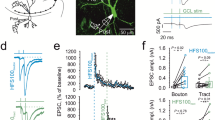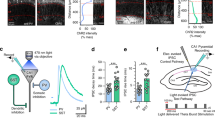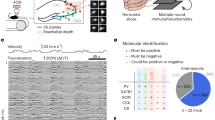Abstract
The hippocampus, a brain structure essential for memory and cognition, is classically represented as a trisynaptic excitatory circuit. Recent findings challenge this view, particularly with regard to the mossy fibre input to CA3, the second synapse in the trisynaptic pathway1. Thus, the powerful mossy fibre input to CA3 pyramidal cells might mediate both synaptic excitation and inhibition2,3. Here we show, by recording from connected cell pairs in rat entorhinal–hippocampal slice cultures, that single action potentials in a dentate granule cell evoke a net inhibitory signal in a pyramidal cell. The hyperpolarization is due to disynaptic feedforward inhibition, which overwhelms monosynaptic excitation. Interestingly, this net inhibitory synaptic response changes to an excitatory signal when the frequency of presynaptic action potentials increases. The process responsible for this switch involves the facilitation of monosynaptic excitatory transmission coupled with rapid depression of inhibitory circuits. This ability to immediately switch the polarity of synaptic responses constitutes a novel synaptic mechanism, which might be crucial to the state-dependent processing of information in associative hippocampal networks.
This is a preview of subscription content, access via your institution
Access options
Subscribe to this journal
Receive 51 print issues and online access
$199.00 per year
only $3.90 per issue
Buy this article
- Purchase on Springer Link
- Instant access to full article PDF
Prices may be subject to local taxes which are calculated during checkout




Similar content being viewed by others
References
Bischofberger, J. & Jonas, P. Two B or not two B: differential transmission at glutamatergic mossy fiber–interneuron synapses in the hippocampus. Trends Neurosci. 25, 600–603 (2002)
Acsády, L., Kamondi, A., Sík, A., Freund, T. & Buzsáki, G. GABAergic cells are the major postsynaptic targets of mossy fibers in the rat hippocampus. J. Neurosci. 18, 3386–3403 (1998)
Walker, M. C., Ruiz, A. & Kullmann, D. M. Monosynaptic GABAergic signaling from dentate to CA3 with a pharmacological and physiological profile typical of mossy fiber synapses. Neuron 29, 703–715 (2001)
Zimmer, J. & Gähwiler, B. H. Cellular and connective organization of slice cultures of the rat hippocampus and fascia dentata. J. Comp. Neurol. 228, 432–446 (1984)
Frotscher, M. & Gähwiler, B. H. Synaptic organization of intracellularly stained CA3 pyramidal neurons in slice cultures of rat hippocampus. Neuroscience 24, 541–551 (1988)
Frotscher, M. Mossy fiber synapses on glutamate decarboxylase-immunoreactive neurons: evidence for feed-forward inhibition in the CA3 region of the hippocampus. Exp. Brain Res. 75, 441–445 (1989)
Schwartzkroin, P. A., Scharfman, H. E. & Sloviter, R. S. Similarities in circuitry between Ammon's horn and dentate gyrus: local interactions and parallel processing. Prog. Brain Res. 83, 269–286 (1990)
Spruston, N., Lübke, J. & Frotscher, M. Interneurons in the stratum lucidum of the rat hippocampus: an anatomical and electrophysiological characterization. J. Comp. Neurol. 385, 427–440 (1997)
Siegel, S. J. et al. Regional, cellular, and ultrastructural distribution of N-methyl-d-aspartate receptor subunit 1 in monkey hippocampus. Proc. Natl Acad. Sci. USA 91, 564–568 (1994)
Jonas, P., Major, G. & Sakmann, B. Quantal components of unitary EPSCs at the mossy fibre synapse on CA3 pyramidal cells of rat hippocampus. J. Physiol. (Lond.) 472, 615–663 (1993)
Debanne, D., Guérineau, N. C., Gähwiler, B. H. & Thompson, S. M. Action-potential propagation gated by an axonal IA-like K+ conductance in hippocampus. Nature 389, 286–289 (1997)
Miles, R. Synaptic excitation of inhibitory cells by single CA3 hippocampal pyramidal cells of the guinea-pig in vitro. J. Physiol. (Lond.) 428, 61–77 (1990)
Debanne, D., Guérineau, N. C., Gähwiler, B. H. & Thompson, S. M. Physiology and pharmacology of unitary synaptic connections between pairs of cells in areas CA3 and CA1 of rat hippocampal slice cultures. J. Neurophysiol. 73, 1282–1294 (1995)
Jung, M. W. & McNaughton, B. L. Spatial selectivity of unit activity in the hippocampal granular layer. Hippocampus 3, 165–182 (1993)
Thompson, S. M. & Gähwiler, B. H. Activity-dependent disinhibition. I. Repetitive stimulation reduces IPSP driving force and conductance in the hippocampus in vitro. J. Neurophysiol. 61, 501–511 (1989)
Brown, T. H. & Johnston, D. Voltage-clamp analysis of mossy fiber synaptic input to hippocampal neurons. J. Neurophysiol. 50, 487–507 (1983)
Chicurel, M. E. & Harris, K. M. Three-dimensional analysis of the structure and composition of CA3 branched dendritic spines and their synaptic relationships with mossy fiber boutons in the rat hippocampus. J. Comp. Neurol. 325, 169–182 (1992)
Geiger, J. R. & Jonas, P. Dynamic control of presynaptic Ca2+ inflow by fast-inactivating K+ channels in hippocampal mossy fiber boutons. Neuron 28, 927–939 (2000)
Llano, I. et al. Presynaptic calcium stores underlie large-amplitude miniature IPSCs and spontaneous calcium transients. Nature Neurosci. 3, 1256–1265 (2000)
Liang, Y., Yuan, L. L., Johnston, D. & Gray, R. Calcium signaling at single mossy fiber presynaptic terminals in the rat hippocampus. J. Neurophysiol. 87, 1132–1137 (2002)
Hallermann, S., Pawlu, C., Jonas, P. & Heckmann, M. A large pool of releasable vesicles in a cortical glutamatergic synapse. Proc. Natl Acad. Sci. USA 100, 8975–8980 (2003)
Henze, D. A., Wittner, L. & Buzsáki, G. Single granule cells reliably discharge targets in the hippocampal CA3 network in vivo. Nature Neurosci. 5, 790–795 (2002)
Miles, R. & Wong, R. K. Excitatory synaptic interactions between CA3 neurones in the guinea-pig hippocampus. J. Physiol. (Lond.) 373, 397–418 (1986)
Nakazawa, K. et al. Requirement for hippocampal CA3 NMDA receptors in associative memory recall. Science 297, 211–218 (2002)
Yeckel, M. F., Kapur, A. & Johnston, D. Multiple forms of LTP in hippocampal CA3 neurons use a common postsynaptic mechanism. Nature Neurosci. 2, 625–633 (1999)
Kobayashi, K. & Poo, M. M. Spike train timing-dependent associative modification of hippocampal CA3 recurrent synapses by mossy fibers. Neuron 41, 445–454 (2004)
Galarreta, M. & Hestrin, S. Frequency-dependent synaptic depression and the balance of excitation and inhibition in the neocortex. Nature Neurosci. 1, 587–594 (1998)
Varela, J. A., Song, S., Turrigiano, G. G. & Nelson, S. B. Differential depression at excitatory and inhibitory synapses in visual cortex. J. Neurosci. 19, 4293–4304 (1999)
Gähwiler, B. H., Thompson, S. M., McKinney, R. A., Debanne, D. & Robertson, R. T. in Culturing Nerve Cells 2nd edition (eds Banker, G. & Goslin, K.) 461–498 (MIT Press, Cambridge, Massachusetts, 1998)
Feldmeyer, D., Egger, V., Lübke, J. & Sakmann, B. Reliable synaptic connections between pairs of excitatory layer 4 neurones within a single ‘barrel’ of developing rat somatosensory cortex. J. Physiol. (Lond.) 521, 169–190 (1999)
Acknowledgements
We thank H. Blum, S. Giger, H. Kasper, L. Rietschin, and R. Schöb for technical assistance, and P. Streit for help in image processing. This work was funded by the Swiss National Science Foundation, the NCCR on Neural Plasticity and Repair, and the Hartmann Müller Foundation.
Author information
Authors and Affiliations
Corresponding author
Ethics declarations
Competing interests
The authors declare that they have no competing financial interests.
Supplementary information
Supplementary Figure 1
Morphology of a typical GC (a) and examples of synaptic contacts in GC-IN pairs (b-i). (JPG 111 kb)
Supplementary Figure 2
Morphology of a representative GC-PC pair. (JPG 64 kb)
Rights and permissions
About this article
Cite this article
Mori, M., Abegg, M., Gähwiler, B. et al. A frequency-dependent switch from inhibition to excitation in a hippocampal unitary circuit. Nature 431, 453–456 (2004). https://doi.org/10.1038/nature02854
Received:
Accepted:
Issue Date:
DOI: https://doi.org/10.1038/nature02854
This article is cited by
-
Region-selective control of the thalamic reticular nucleus via cortical layer 5 pyramidal cells
Nature Neuroscience (2023)
-
Imaging brain tissue architecture across millimeter to nanometer scales
Nature Biotechnology (2023)
-
Resistive switching and artificial synaptic performances of memristor based on low-dimensional bismuth halide perovskites
Nano Research (2023)
-
The Role of the Dentate Gyrus in Mediating Hippocampal Functions: The Healthy Brain
Neuroscience and Behavioral Physiology (2023)
-
High-efficiency resistive switch and artificial synaptic simulation in antimony-based perovskite devices
Science China Technological Sciences (2023)
Comments
By submitting a comment you agree to abide by our Terms and Community Guidelines. If you find something abusive or that does not comply with our terms or guidelines please flag it as inappropriate.



